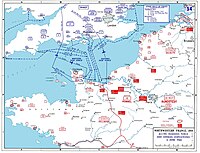Portal:France/Featured article/2012/06
The Battle of Normandy was fought in 1944 between Nazi Germany in Western Europe and the invading Allied forces as part of the larger conflict of World War II. Over sixty years later, the Normandy invasion, codenamed Operation Overlord, still remains the largest seaborne invasion in history, involving almost three million troops crossing the English Channel from England to Normandy in then German-occupied France.
The primary Allied formations that saw combat in Normandy came from the United States of America, United Kingdom and Canada. Substantial Free French and Polish forces also participated in the battle after the assault phase, and there were also contingents from Belgium, Czechoslovakia, Greece, the Netherlands, and Norway.
The Normandy invasion began with overnight parachute and glider landings, massive air attacks and naval bombardments, and an early morning amphibious assault on June 6, “D-Day.” The battle for Normandy continued for more than two months, with campaigns to establish, expand, and eventually break out of the Allied beachheads, and concluded with the liberation of Paris and the fall of the Falaise pocket in late August 1944.
The various factions and circuits of the French Resistance (also known as the Maquis) were included in the plan for Overlord. Groups were tasked with attacking railway lines, ambushing roads, or destroying telephone exchanges or electricity sub-stations. They were to be alerted to carry out these tasks by means of the messages personnels, transmitted by the BBC in its French service from London. Several hundreds of these were regularly transmitted, masking the few of them that were really significant.

